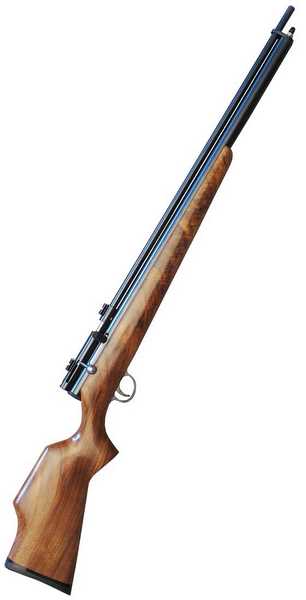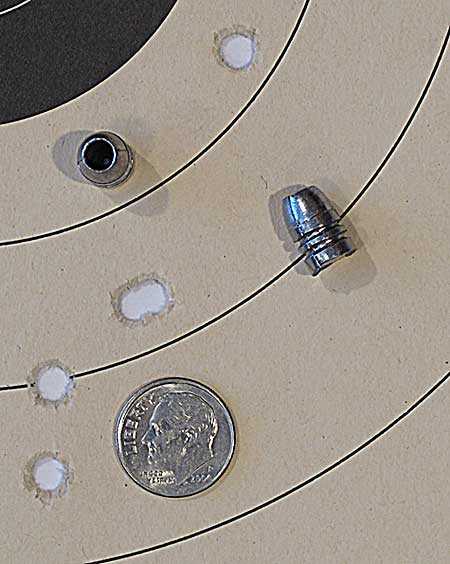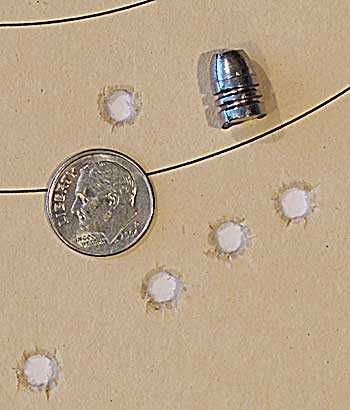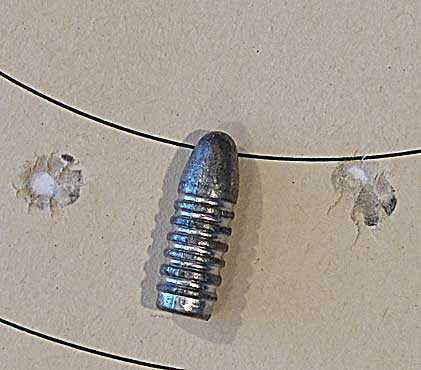by B.B. Pelletier

Quackenbush .308 big bore is an attractive airgun.
The last time we looked at this Quackenbush .308 big bore was when I discovered that my rifle really likes Mr. Hollowpoint’s 68-grain hollowpoint bullet. I also tested a 150-grain Loverin-design bullet that was just a bit too heavy for the gun. It didn’t want to stabilize and was tearing elongated holes in the target at 50 yards.
If you’ll recall, I was running low on air that day, so I could fill the rifle to only 3,000 psi. That gave a stunning group that was smaller than one inch at 50 yards with the 68-grain hollowpoint, but I wondered whether it would do any better if I filled the rifle to higher pressure. I also wondered if going just a trifle faster would have stabilized the 150-grain bullet. There were a lot of unanswered questions after the last test.
Today, I’ll address those questions. I had a full air tank and a reasonably good day at the range. Certainly for testing something as stable as a .308, the light breeze was no challenge.
Shooting the 68-grain hollowpoints
I decided to fill the rifle to 3,500 psi, to see what kind of velocity that might give. The 68-grain bullet averaged 1051 f.p.s, on that much air and left about 3,100 psi in the tank for the second shot. That’s a muzzle energy of 167.15 foot-pounds.
Shot two averaged 1,010 f.p.s. with the same 68-grain bullet and generated 154.07 foot-pounds of energy. You might think that’s close enough to the first velocity that the bullets will print in the same place. They might if this was a firearm — but it’s an air rifle, and we have to take the flexing of the horizontal air reservoir into account. As the pressure inside the air reservoir changes, the reservoir — which is a long tube — flexes a tiny bit. Since it’s connected to the barrel, this flexing can cause movement in the muzzle.
The first shots printed about two inches higher on the target than the second shots. I knew they would from past experience shooting other big bores, so this came as no surprise to me. I actually shot one group of first shots (after a 3,500 psi fill) at one target and a separate group of second shots at a second target.
After seeing where the shots landed relative to the aim point, it’s possible to use the mil-dot reticle in my scope to shoot both shots into the same group by using two different aim points. This is a technique I learned several years ago with my .458 Outlaw; and with it, I can put five bullets into one inch at 50 yards. I didn’t try that on this day, however, because I was too busy learning the gun.
Neither group obtained this day was as good as the group I shot last time on just 3,000 psi of air. The first group that was shot on 3,500 psi measured 2.72 inches between centers for five shots, though four of those shots landed in a group measuring 1.219 inches.

Four of the five bullets were close at 50 yards on 3,500 psi. Two landed in the same hole.
The group that was fired on 3,100 psi measured 1.953 inches between centers. That’s twice the size of the best group that was shot several weeks ago on 3,000 psi, so I think this bullet is going too fast for best results. It looks to me like this 68-grain hollowpoint wants no more than 3,000 psi as a max charge. That would put the velocity at around 970-980 f.p.s.

Lower starting pressure gave a tighter group. This one was made with 3,100 psi.
Did the 150-grain bullets stabilize?
Again, the 150-grain bullets failed to completely stabilize — even when driven to 825 f.p.s (on 3,600 psi air) and generating 226.75 foot-pounds of energy at the muzzle.

Both bullet holes show evidence of tipping. The bullet is not stabilized.
Clearly, this Loverin bullet is too long to stabilize at the velocity this rifle generates. What’s needed is a 120- to 130-grain bullet that’s short, which means it must have either a round or a flat nose.
Some observations
I’m seeing a relationship between soft pure lead bullets and better accuracy. Any hardening alloy seems to open up the group.
Ditto for lubricated bullets. So far, the best, most accurate bullets are those that are completely dry. I see now that I need to cast some more 130-grain bullets in lead that is as pure as I can make it, and shoot them absolutely dry. I’ve seen the performance of pure lead bullets on game, and they hold together far better than hard alloy bullets do. Lead hardened with antimony breaks apart in large chunks, while soft lead mashes up like a wad of bubble gum when it hits game.
I’ve always questioned using a .308 for game as large as a deer. I know hunters who are better shots than I am do it all the time and have great success, but for me the .308 is more of a coyote and bobcat round. I’ll leave the deer and wild hogs to the .458 and keep this .308 for smaller game. It probably has a useful range of 125 yards in my hands. For an air rifle, that’s pretty far!

A bit off-topic
Edith the links to the last few blogs is gone from the mainpage again.
J-F
J-F,
Thanks. I notified IT. I have no idea why this continues to happen..
Edith
Knowing new technology. It will probably resolve itself in a few month. lol
Yeah. The RSS feed is wacky.
The numbers here are a useful index for me of the difference in power between firearms and air rifles. A 68 grain bullet for a .308? And it’s no surprise that a 150 grain bullet would have trouble stabilizing at 800 odd fps when my Garand fires it at 2800 fps. Is length a factor in stabilization or weight…or both? But I am impressed that the .308 can be effective out to 150 yards which is beyond my sense of airgun distances.
Okay, a 2000 pound 16 inch round would take some heavy lifting. It looked like they had somewhat less than 10 men on the gun. Barely doable even on adrenaline.
Matt61
Matt,
Length is a factor, but weight is even more of a factor.
B.B.
And for a wonderful and all-too-brief two weeks training duty back circa 1980 I ran a small group at the Naval Sea Systems Command doing the conceptual design for new ammunition to be shot from those 16 inch naval rifles.
We looked at some of the anti-personnel ideas, including the flechette dispenser (too gruesome for words, but very effective), a multi-payload long range sabot round (a bit like the one that almost made it into service), and furthest out of all, a two-stage anti-tactical ballistic missile launched using the gun as a booster [that’s garbled; what I mean is that we wanted to shoot a 16″ round where the payload was a heat-seaking or radar-guided ATBM with one or two stages independent of the gun boost]. I got to follow that one as a consultant for another year or two, but ultimately it foundered; the rocket admirals won using a simpler and probably better design adaptating the Standard Missile.
Another good idea which was adapted for smaller guns was to put a small rocket in the tail of the projectile with just enough thrust to counterbalance drag force. It more than doubled the range with almost no loss in payload.
The idea I liked the best was to make a MIRV package of sonobuoys to fit into the 16″ shell. Fire to extreme range, track entry to the water with radar, and then go looking for submarines. We tried to rescue the idea with a single sonobuoy in the proposed six inch gun — which required firing 3 rounds — but ultimately the Marine Corps lost the battle to put heavier guns back on ships for gunfire support of amphibious landings. Oh well, it was a hell of a lot of fun while it lasted, and I did get close up to a 16″ test mount at Dahlgren Proving Ground.
I think the biggest setback for all of the ideas was when the USS Iowa’s gun misfired killing the turret crew. And then they retired all four of the Iowa-class battlewagons. If you ever get to one of the places where they have a BB on exhibit, I urge you to go. They are fabulous vessels whose time came and went. And while they were heavily used in WW2, Korea, Vietnam and even Iraq(1) they were just too manpower intensive and too expensive to run so ultimately they were retired forever. But they were graceful, beautiful, and when one of them pulled up along side your seacoast, all the action very quickly moved 20 miles inland.
And now I shoot 4.5mm pellets.
pete
With my Souped up Condor I like to call the 25 LBT, because I shoot cast bullets from a specially designed LBT bullet mold for it. I whot four 5 shot groups, they averaged 2.5 inches, at 150 yards.
My Ranger 45 likes to shoot groups around 1 inch at 50 yards for 5 shots with 415 grain bullets and has shot many 2 shot groups, 2 shots per fill at 100 yards
So I would not consider those groups anything special, or even workable.
[IMG]http://i1022.photobucket.com/albums/af343/chbartlemay/cast%20bullets%20for%20condor/DSC07036.jpg[/IMG]
That last post should read, the Ranger 45 shoots two shot groups touching at 100 yards, enough of them to demonstrate it does this often.
Cast bullets in airguns are dependent on one thing first of all, an exact fit of bullet diameter to groove diameter.
Air guns do not have the power to bump up under size bullets and to swage down a cast bullet with air is a thief of energy. PB’s can do this but air guns can’t.
Slug that bore BB, get some or cast some slugs that can be sized to the exact groove diameter and you will shoot groups that show what a superb rifleman you are.
Hi Roachcreek! Until now I hadn’t put together your screen name….but the 25LBT certainly rings familiar! I have really enjoyed reading about the chokeless Condor on various forums…thank you.I also envy both your shooting grounds,……and that Leupold.
I believe you are spot on (not that you need my affirmation) about the importance of bore fit for an accurate bigbore projectile.I have several DAQ .308s….the one I’m shooting with now is stabilizing a 156gr projectile and I suspect the dia. of the 150gr BB shot was a bit small.
Do I recall correctly that without the choke…….Kings are still shooting well?
Roachcreek,
Thank you for your encouragement and advice. I certainly don’t have the experience with this Quackenbush that many others have. I don’t know if you saw the group I shot with the 68-grain bullet in the last report, but 3,000 psi seems to work best for this bullet in this rifle.
I will slug the bore and we will go from there.
B.B.
BB,At 50 yards with 2″ drop would that be even feasible to crank the scope turret? I’ve always wondered how many times we can crank scopes like these up and down before they are ruined.My Evanix Hunting master AR-6 is touted to be accurate at 75 yards and I’ve always wanted to try it at 100,even 120 yards or more if possible.The scope I put on it has a choke style rangefinder with 7 horizontal lines at 5moa increments under the cross-hairs.The first 5moa are also marked at 1moa intervals in all 4 directions.With 3000psi in her tank the Evanix will fire Eun Jin 32.4 gn.pellets to 899fps developing over 58fpe.With my scope zeroed at 75 yards for regular shooting ,I hoped to be able to use those lower horizontal lines for zeroing at specific further ranges.Do you think they will correlate well,and how far would this be practical?After setup I plan to shoot (of coarse)tin cans as targets so hunting accuracy would not be needed.Thank You.–Tin Can Man–
Tin Can Man,
I think there will be some sort of correlation with the choke stadia in your scope, but only experimentation will tell for certain. That’s how I determine which mil dot to use when I super-elevate the gun for the second shot.
Good luck finding the relationship (not meant as sarcasm!). 🙂
B.B.
Frank,
I have two 25 LBT’s that shoot 56 grain cast bullets a carbine that shoots @ 770 to 850 depending on the PW setting and the rifle at 930 FPS.
The carbine will shoot the Kings into 1/2 inch at 40 yards at 950FPS or so if I push them past the lead I have cut in to facilitate chambering the LBT bullets, The rifle is shooting too fast to get good accuracy with the Kings.
The Leupold you refer to is a VXIII LR 4.5×14 Long Range, M1 turrents has the Hollands MOA reticle, it has MOA numbers from 2 to 24 to give repeatable drop reference from 80 to 200 yards with the 25 LBT. It also has 106 MOA of adjustment to get me out to the 280 yard range I shoot at.
My target is a 3×4′ sheet of 3/16th steel with a extended 8 inch steel bull. These two surfaces give two distinct sounds when hit and instead of using pasters I use spray paint.
Air guns can shoot accuratly beyond 150 yards if you use cast bullets, the Diablo design does not seem to lend itself to long range accuracy and exhibits a high percentage of corkscrew flight at long range, but it was never designed as a long range projectile.
Cast bullets in my research with the 25 LBT, do not lend themselves to good performance with a choked barrel. I sent thousands of them down range trying to find the magic combination of weight, size, alloy, lube, hammer weight/springs, hammer enertia/shock and velocity. Then I cut the choke off the LW barrel and the results were dramatic. Groups instantly showed remarkable improvement and continue to improve as I learn more.
I purchased four molds in this pursuit, the last being a custom mold from LBTmolds in Idaho, that was made to drop .256 bullets that are sized to .255 for my .2549 bore. For my Ranger 45 I had Accuratemolds make my 415 grain mold, I had been sizing to .452, but once I poolished the bore, I find that shooting them as they drop at .454 works better. I suspect a .453 sizing die is the best option.
Custom sizing dies can be had from Lee Precision, they must be custom ordered and take 3 weeks to 3 months and cost $35.00. They are used in a conventional loading press, I use a $20.00 portable Lee hand press.
Having fired thousands of cast bullets thru the 25 LBT, my $150.00 mold and $35.00 press are paid for. I make my air with a Shoebox, if I recyle my alloy, my shooting an air rilfe that gives the same energy at 150 yards that a 25 ACP does at the muzzle, shoots an average of 2.5 inches at 150 yards is almost free.